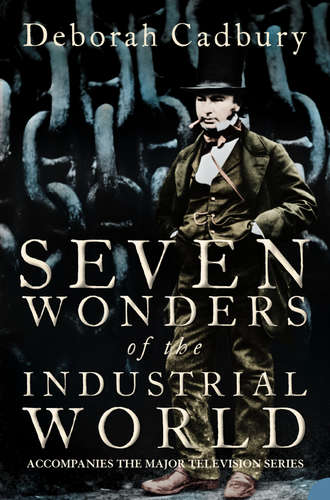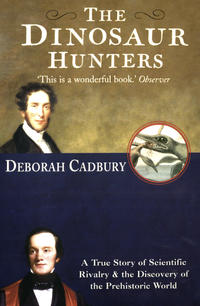
Полная версия
Seven Wonders of the Industrial World
Most ships docking in the Thames in the mid-nineteenth century were made of wood and built to a traditional design around a skeleton of wooden ribs giving strength to the hull. They were wind powered and usually little more than 150 feet in length. Brunel’s ‘Great Ship’, as she came to be known, was to be 692 feet long, 120 feet wide and 58 feet deep. Enormous engines as high as a house, with the power of over 8,000 galloping horses, would drive her paddle wheels and screw. In addition, an impressive 6,500 yards of sail would be carried on six masts and five funnels that were spread along her deck. The revolutionary new design of her hull, strong and streamlined, would see her cut through the seas as smoothly as a knife cuts butter and she would have the practical ability to carry all her own fuel to the furthest reaches of the empire and back. Brunel felt certain there was a need for such a ship.
To most shipbuilders of the day, Brunel’s Great Ship would have seemed an unattainable, magnificent dream, but Brunel had a way with dreams – his ‘châteaux d’Espagne’. At twenty, he had risked his life as engineer on the first tunnel under the Thames. At twenty-four he was elected a member of the Royal Society. He went on to design five suspension bridges including the magnificent Clifton Suspension Bridge at Bristol, as well as wet and dry docks, tunnels and piers. In 1833, he became engineer-in-chief to the Great Western Railway. His trains, speeding at 50 m.p.h. past fields and villages, opened up England and joined distant cities. He surveyed and planned the route from Paddington to Bristol, designing the track, cuttings, tunnels, stations and trains – even the signal boxes and at least 125 bridges on the route west. As he built the Great Western Railway, his dreams became even grander. He imagined large steamships that would go further west, sailing out across the Atlantic to America, shrinking the world’s oceans and creating a global system of transport.
Brunel launched the Great Western in 1837, which although constructed traditionally in wood was the largest steamship ever built and faster too. In 1843, he surpassed this with his second ship, the Great Britain, which at nearly 322 feet long and 50 feet wide was the first large iron screw steamship, with a new design of hull and increased emphasis on longitudinal strength. The Great Britain was not built in the traditional rib design; instead, ten iron girders ran the length of the vessel at the base. Everything about the ship was designed for strength and she became an extremely profitable vessel on the Australia run. In 1851, with the discovery of gold in Australia, and increasing demand for passenger and mail traffic to the East, Brunel could see a commercial possibility for an even bigger ship. ‘Size in a ship is an element of speed,’ he argued, ‘and of strength and of safety and of great relative economy.’
In the spring of 1852, Brunel approached the leading naval architect of the day, John Scott Russell, to seek advice about the feasibility of his plan for the Great Ship. Scott Russell had made his name streamlining the design of ships’ hulls for maximum efficiency with his ‘wave-line theory’. Brunel admired him and respected his achievements, notably his original work on hull design. ‘With respect to the form and construction of the vessel itself,’ said Brunel, ‘nobody can, in my opinion, bring more scientific and practical knowledge to bear than Mr Scott Russell.’
Scott Russell was equally impressed with Brunel and his extraordinary idea for the Great Ship. He suggested that they present the plan for the vessel to the Eastern Steam Navigation Company. This company had recently lost the mail contract to the Far East to the Peninsular and Oriental Steam Navigation Company and were thought to be looking for a way to revive their fortunes on the route to India, China and Australia. Although a committee at the Eastern Steam Navigation Company decided in favour of the plan and appointed Brunel as engineer, the proposal caused a heated debate with some directors resigning. Indeed, Brunel soon learnt that ‘certain of the directors … opposed me personally’.
Undeterred, he threw himself into finding others interested in the project, and by the time capital for the venture was found, more than half of the new directors were nominated by Brunel. Charles Geach, MP for Coventry and chairman of the Midland Bank, was an important member of the committee and a business associate of Scott Russell to whom he supplied iron from a smelting company where he was a partner. Brunel, aware that most of the directors were of his choosing, felt ‘the heavy responsibility of having induced more than half the present directors of the company to join’. The fact was, he admitted, ‘I never embarked on any one thing to which I have so entirely devoted myself and to which I have devoted so much time, thought and labour, on the success of which I have staked so much reputation.’
By May 1853, enough shares had been sold to make a start and Scott Russell presented his estimate to the board for £377,200 to build the ship. The hull was £275,200, the screw engines were £60,000 and the paddle engines and boilers were £42,000. Since Brunel had calculated the cost of the ship as somewhere near half a million pounds, the board was delighted with Scott Russell’s price. Scott Russell had, however, seriously underestimated his costing. He wanted the commission so much that it is possible that he put in a low bid to ensure he got it, but the subsequent shortage of funds was to put the venture in jeopardy.
Soon Scott Russell faced further difficulties when, in September 1853, fire broke out in his shipyard. As the flames licked hungrily around the carpenters’ shop, the boilermakers’ shop and the timberyard, the London fire brigade ‘hurried towards the seat of the calamity … [but] unfortunately the light of the fire deceived them,’ reported The Times. They galloped at full speed down the wrong side of the river and were almost at Deptford before they realised where the fire was raging. In their rush back across London Bridge, ‘a body of the fire brigade were nearly killed as the horses galloped with the engine into a hole eight feet deep, pitching all the firemen off the machine’. It took over an hour for the fire engines to reach the scene, by which time the fire was well entrenched. By the light of day everything in Scott Russell’s yard was reduced to charred, black, smoking stumps. The damage was estimated at around £140,000 and most of the yard had not been insured.
A worrying and faintly discordant background to the ambitious project was becoming discernible. Russell’s yard was temporarily demolished and he was financially embarrassed. His yard lacked supervision, too, and with no provision for safeguarding large supplies, pilfering was rife. And, despite the fact that the Great Eastern was twice the size of any previous ship, she was to be built in a traditional shipyard with no special arrangements made for her construction. In this vaguely uneasy situation, Brunel insisted on total control.
Finally, in December 1853, all parties signed contracts for the Great Ship. Scott Russell was to build the hull and paddle engines, the celebrated James Watt and Co. would build the screw engines and Brunel was to approve all changes and drawings at every stage of the construction process. ‘I cannot act under any supervision,’ he said, ‘or form part of a system that recognises any other adviser than myself.’ Indeed, everything concerning the Great Ship was to be ‘to the entire satisfaction of the engineer’.
However, conflicts soon arose over the methods of payment. Brunel wanted to pay Scott Russell as work progressed, calculated on the amount of iron put into the ship on a monthly basis; this was the custom adopted for his railway contracts. Scott Russell, meanwhile, expected to be paid lump sums on a more regular basis so that he had sufficient cash to meet expenses. Liquidity, which had always been a problem for Scott Russell, was now made worse as some of his payment for work on the hull was in company shares, although Charles Geach helped by taking shares as payment for his iron instead of cash.
The most immediate practical concern for Brunel was where to build and launch his ship. The contract had stipulated that the ship be built in a dry dock but Scott Russell’s yard was too small for Brunel’s vast project. Scott Russell, needing more space, rented Napier shipyard adjoining his at Millwall to accommodate the construction of the hull. They realised that building the ship on an end slip was impossible; the bow would be 100 feet in the air during construction. It was also out of the question to launch a 700-foot-long ship stern first in the traditional way, when at that point the river was a mere 1,000 feet wide. After much deliberation, Brunel decided to build the ship on the bank parallel to the river and launch her into the Thames sideways down a gentle slope. To prepare the site, 2,000 oak beams up to 40 feet long were piled 5 feet apart into the shore, leaving 4 feet above ground. Further packing was then added and the flat-bottomed hull would rest on two large cradles.
In March 1854, just as they were finally ready to start construction work on the hull, Britain entered the Crimean War. With supplies needed for the military, the price of iron rose rapidly. A few months later, Scott Russell faced another major setback: the unexpected death of Charles Geach. ‘The Honourable Member had returned from his Scotch shooting in unusually good health,’ reported The Times. However, he had been suffering from a dangerous infection in his leg. A change for the worse occurred, ‘and after much suffering borne with the greatest fortitude and resignation, Mr Geach expired at half past 4 o’clock yesterday afternoon’.
This was a disaster for Scott Russell. Geach was crucial to the iron supply and was the one person who had accepted flexible terms of payment on this immensely expensive project. Scott Russell’s solution was a dangerous one. Unknown to Brunel and the other directors, he secretly mortgaged his shipyard, thereby putting the Great Ship at risk. Brunel had not worked closely on a financial venture before with Scott Russell and was unaware, at this point, of the danger signals beginning to emerge that could affect the future of his ‘Great Babe’, as he affectionately nicknamed his new creation.
In spite of the precarious financial situation, the hull was slowly rising, a massive dark shape against the water and sky. It was being built at a big southerly bend in the river at Millwall on the Isle of Dogs, about six miles down river from Westminster and 40 miles to the open sea. This was an undeveloped part of London, previously the haunt of wildlife, with little but ‘marshy fields and muddy ditches, with here and there, a meditative cow cropping herbage’. Now it was the site of a technological revolution that would inspire shipbuilding for years to come.
Brunel’s original idea for the design of the hull was evolved from lessons learnt in his bridge-building days. A key innovation was to have a double hull, heavily braced up to the water line, one hull inside the other and 2 foot 10 inches apart. These were to be constructed from 30,000 iron plates, each 3/4 inch thick. The deck, too, would consist of two thicknesses of 1/2 inch iron plate. Strength was further guaranteed by longitudinal and transverse bulkheads. According to Scott Russell, ‘the longitudinal system is carried throughout unbroken, without interruption by the bulk heads’ and the watertight transverse bulkheads, 60 feet apart the length of the ship, made her, it was hoped, virtually unsinkable. With this cellular double hull, the bulkheads and the strong watertight deck, Brunel compared the strength of the hull to that of a box girder.
This unique vessel was to be powered by both screw and paddle engines to give greater flexibility and manoeuvrability. The engines themselves would be giants, 40 feet high; the cylinders on the screw engines alone had a bore of seven feet by fourteen. And before the crankshaft for the paddle engines could even be made, new larger furnaces had to be built.
The giant hull was attended by an army more than a thousand strong of riveters, bashers and shipwrights. Men were busy inside, outside, high up, low down, creeping and crawling between the hulls, up at the bow, down at the stern, hammering, clanking, banging, carting iron, moving wood and hammering the rivets. Swarming all over the ship, they gave the impression of ants on a giant carcass. Depending on the light, men worked twelve-hour days and a skilled man could earn 30 to 40 shillings a week. There was no certainty of continued employment and plenty of men were waiting to step into the shoes of anyone who left their work.
The noise coming from the shipyard was deafening. The ringing sound of metal hitting metal reverberated throughout the hull. Two hundred riveting teams working both inside and outside the hull hammered unceasingly at a total of three million one-inch-thick, white-hot rivets. Each rivet would be held in place by a man on the other side of the plate. Children were employed as part of the team tending the forge and placing the heated rivets in the holes. They were particularly useful working in the double hull, where with limited space it was difficult for a man to manoeuvre. Working in the dark, confined space of the double hull, it did not do to lose concentration, even after a twelve-hour shift. One moment of carelessness could be paid for with a hand, or an arm, or a life.
Accidents were commonplace. It was all too easy to miss a step and, falling from a height, involve another man in disaster in the overcrowded conditions. One worker who was making bolts got his hands tangled in the machinery and torn completely from their sockets at the wrist. In his case, amputation of both arms was the only solution. Yet another man, curious about the working of a piledriver, was bent over examining the machinery when the hammer came down, flattening his head. Children were particularly vulnerable. They could be working in the yard as young as nine or ten. One unfortunate child fell from a height and was impaled on an upright iron bar. According to one witness, ‘after he was dead, his body quivered for some time’. There was always another boy willing to take his place for a shilling or two. A rumour persisted at this time that a riveter and his boy had somehow been forgotten and were entombed alive in a section of hull. Months later, workers said they could hear the ghosts hammering, trying to escape. Most were sure this tragedy would put a curse on the ship.
As work progressed it became apparent that Brunel and Scott Russell, the two great men locked into building this ship together, were very different in style and temperament. Brunel was married to his work, always absorbed in every detail. He thought nothing of getting dirty in the course of a working day. His wife, Mary, known as ‘the Duchess of Kensington’ on account of her beauty and style, rarely saw him at their elegant London home because he worked eighteen hours a day. Scott Russell, on the other hand, had a more relaxed managerial style – he delegated. As he sat in his impressive office, he expected the chain of command to work perfectly around him. He did not expect to get his beautifully tailored clothes dirty and left the management of the site to his yard managers, Hepworth and Dixon, who were responsible for the shipwrights. Increasingly, Brunel and Scott Russell found themselves in disagreement.
As the work on the Great Ship progressed and her shape became more evident, the press began to take an interest. They estimated that the Leviathan or Great Eastern, as she became known, had greater dimensions even than Noah’s Ark. ‘Great Eastern Fever’ began to spread throughout the country and the ship soon came to symbolise the ‘moral supremacy’ of the British Empire. Yet for all the growing national excitement, a serious rift between Brunel and Scott Russell was to emerge.
An article in The Observer in November 1854 sparked the first open clash. The paper had mistakenly credited Scott Russell with playing the major role in the design of the Great Ship. They quoted him ‘as carrying out the design’ and claimed that Mr Brunel had merely ‘approved of the project’. Brunel was furious and he wrote to Eastern Steam company secretary John Yates, correcting this error in no uncertain terms. He strongly suspected that Russell or one of his men had leaked the article. ‘This bears rather evidently a stamp of authority, or at least it professes to give an account of detail which could only be obtained from ourselves,’ he wrote. ‘I cannot allow it to be stated, apparently on authority, while I have the whole heavy responsibility of success resting on my shoulders, that I am the mere passive approver of the project of another, which in fact originated solely with me and has been worked out by me at great cost of labour and thought devoted to it for not less than three years.’ Quite how the information had reached The Observer was never ascertained.
Difficulties increased during the winter of 1854 with Scott Russell facing growing financial problems following the death of Charles Geach. His bank refused to give him any more credit, so he asked the board of Eastern Steam if he could be paid in future on a regular monthly basis for work accomplished. In April 1855, there was another fire at his yard and, while no damage was done to the Great Ship, he bore a further loss of £45,000. Faced with these difficulties and endless delays in construction at Scott Russell’s yard, Brunel was reluctantly forced to concede that the launch date, originally planned for October 1855, would have to be deferred.
A fundamental conflict between the two men arose over the method of launching the Great Ship. At an estimated 12,000 tons, this was the largest weight ever moved by man and it needed to be moved 200 feet into the river. Brunel had given much thought to the problem and had come to the conclusion that the only way to achieve this was through a ‘controlled’ launch. This was a most unusual procedure. Pushing the mighty 700-foot-long ship sideways into the river seemed fraught with problems, but Brunel, undaunted, insisted it was the only way to launch her. Anything else would be a disaster. He envisaged the possibility of the ship getting stuck or, worse, moving into the river far too quickly and keeling over or breaking up. He preferred to err on the side of caution and planned to use restraining chains to control the ship’s progress gently down the slope.
Scott Russell was totally opposed to a controlled launch. He pointed out that ‘free’ launches, admittedly of smaller ships, were carried out on the Great Lakes of America successfully. He was also worried about the cost of a controlled launch. Since Scott Russell was under contract to launch the ship and Brunel’s plan was estimated to cost an extra £10,000, he was not to be moved on this subject.
Throughout the spring and summer of 1855, Brunel was concerned as Scott Russell became increasingly uncooperative. He would be unavailable, slow in replying to letters and vague with the information that he did give. Brunel needed specific facts that would enable him to work out launching requirements and his irritation with Scott Russell grew. ‘I begin to be quite alarmed at the state of your contract,’ he wrote. ‘Four months are gone and I cannot say even the designs are completed … to justify a single bit of work being proceeded with.’ In May 1855, he wrote again to Russell in an exasperated tone: ‘Your reply this morning to my long list of complaints is an admirable specimen of an Under-Secretary’s reply in the House to a Member’s motion – it does not satisfy one single honest craving for information and for assurance of remedy … I do not want better indicators than usual … Those made on this occasion and to which I object were absurd – like the attempts at writing of a two year old baby.’
As the summer wore on, Scott Russell, faced with yet another fire at his yard, became more and more immersed in his financial uncertainties. And Brunel was totally consumed with giving life to his creation; transforming so many lifeless tons of iron and wood into the majestic shape of his inner vision. To this end he was always occupied, dealing with endless problems and finding endless solutions. He went to Haverfordwest in Wales to organise jetties where the Great Ship would take on coal. He found the man whom he felt had the necessary qualities and experience to captain his great ship: William Harrison. There were also detailed discussions to be had on the design of the engines. Brunel was soon worried to hear that Scott Russell was not fulfilling his contract. It had become apparent that the work on the hull was not commensurate with the amount of money Scott Russell had received. Scott Russell had in fact been paid the bulk of the money, but there was still a massive amount of work to do before the hull was anywhere near complete. Brunel slept only four hours a night and worked like a man possessed.
By late summer, Brunel was still trying to get information from Scott Russell that might affect plans for the launch of the ship. Again, he wrote requesting information from Scott Russell concerning the centre of gravity for the ship and, again, he felt the reply he received was too vague. Scott Russell meanwhile wrote with a request for more money – £37,673 to be precise. He argued that this sum was for extra work – alterations that Brunel had made to the original designs. This led to lengthy arguments and nurtured the growing distrust between the two men. Scott Russell did provide a launch date for March 1856 but infuriated Brunel by carelessly giving the wrong information on the tonnage of the vessel. Brunel was angry. ‘How the devil can you say you satisfied yourself at the weight of the ship,’ he wrote to Scott Russell in October 1855, ‘when the figures your clerk gave you are 1,000 tons less than I make it or than you made it a few months ago – for shame – if you are satisfied. I am sorry to give you more trouble but I think you will thank me for it – I wish you were my obedient servant, I should begin by a little flogging.’
By now, very little charm was wasted in dealings between the two men. Scott Russell replied with a request for more money needed to pay the banker, Martin’s Bank, who held his yard in mortgage. The Great Ship, it seemed, was eating money and he could not obtain credit from anywhere. He wrote again to Brunel insisting on regular payments, saying, ‘I fear I shall get into trouble unless we can see our way to a definite arrangement for the future. I am keeping an enormous establishment of people night and day. I either must have payment with certainty or reduce my number of hands.’ Trying to ease the strain on his finances, Scott Russell had taken orders for six other smaller ships, which he was building in the yard of the Great Ship, and on which the labour force was increasingly deployed. To add to Brunel’s disgust, the smaller craft in the yard were so placed that essential work on the Great Ship was made impossible. And still Scott Russell had not produced the information needed for the launch. Brunel wrote again on 2 December 1855, ‘I must beg you to let me have with the least possible delay the correct position of the centre of flotation at the 15’ draft line … I cannot stand any longer the anxiety I have felt ever since we commenced the ship as to her launching.’
Yet no information was forthcoming from Scott Russell. Whether Scott Russell was deliberately holding back the information Brunel required in the hope that he would be forced eventually into a cheaper uncontrolled launch is not known. Brunel defeated him; he managed to ascertain the centre of flotation and soon had plans prepared for the launching cradles and launch-ways. Scott Russell complained to the board, pointing out that the controlled launch had not been part of the original plan and that the additional cost he faced was prohibitive.
By January 1856, Brunel had finally had enough. He voiced his concerns to the board of the Eastern Steam Navigation Company, reporting that a ‘large deficiency’ in iron ‘appeared to exist’ at the yard which was difficult to understand as ‘I do not now believe that any mistake has been intentionally made or even intentionally overlooked … and have been assured … that none of the iron so imported was ever knowingly used for other purposes … I make the quantity in the yard about 1,400 tons but this would still leave 800 or 900 tons to be accounted for and I am totally at a loss to suggest even a probable explanation.’ To make his position absolutely clear, he went on to say,






